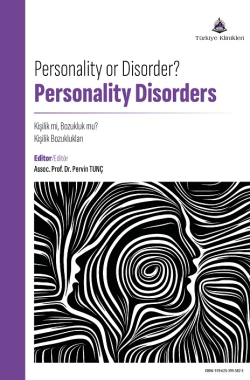Histrionic Personality Disorder
Gizem ATEŞ ÖZKANa , Melek ÖZDENa
aİstinye University Faculty of Humanities and Social Sciences, Department of Psychology, İstanbul, Türkiye
Ateş Özkan G, Özden M. Histrionic personality disorder. Tunç P, ed. Personality or Disorder? Personality Disorders. 1st ed. Ankara: Türkiye Klinikleri; 2025. p.47-54.
ABSTRACT
Histrionic Personality Disorder (HPD) is a mental disorder characterized by excessive emotionality and attention-seeking behavior. In the Diagnostic and Statistical Manual of Mental Disorders 5 (DSM-5), it is classified under Cluster B personality disorders, along with antisocial, borderline, and narcissistic personality disorders. The origins of HPD trace back to the concept of ”hysteria”, which is no longer used for diagnostic purposes today but dates back to Ancient Greece. Various researchers in the 18th and 19th centuries tried to understand hysteria. Freud’s work with hysteria patients pioneered the conceptualization of the hysterical personality, which holds a significant place in the psychoanalytic approach. This chapter focuses on the characteristics of the histrionic personality from a psychodynamic perspective. It outlines the organization level of the histrionic personality, id, drives and affect, defense mechanisms, and object relations. With this chapter, researchers and clinicians are expected to understand HPD and its associated features better. By providing a comprehensive overview of HPD, this chapter aims to reduce misconceptions and offer a better understanding of the condition.
Keywords: Histrionic personality; histrionic; hysteria; personality disorder; psychodynamic approach
Kaynak Göster
Referanslar
- American Psychiatric Association. Diagnostic and statistical manual of mental disorders. 5th ed. Washington, DC: American Psychiatric Association; 2013.
- Şimşek A, Kaya Y. From hysteria to histrionic personality disorder. Social Science Development J. 2020;5:1-12. [Crossref]
- Novais F, Araújo A,Godinho P. Historical roots of histrionic personality disorder. Front. Psychol. 2015;6:1463. [Crossref] [PubMed] [PMC]
- Mitchell J. Mad men and medusas: Reclaiming hysteria. New York: Basic Books; 2000.
- Edwards M. Hysteria. The Lancet. 2009;374(9702):1669. [Crossref]
- Gilman SL, King H, Porter R, RousseauGS, Showalter E. Hysteria beyond Freud. Berkeley: University of California Press; 1993. [Crossref]
- Bogousslavsky J, Walusinski O, Veyrunes D. Crime, hysteria and belle époque hypnotism: The path traced by Jean-Martin Charcot and Georges Gilles de la Tourette. Eur Neurol. 2009;62:193-9.
- Micale MS. Charcot and the idea of hysteria in the male: Gender, mental science, and medical diagnosis in late nineteenth-century France. Medical History. 1990;34(4):363- 411. [Crossref] [PubMed] [PMC]
- Breuer J, Freud S. Studies on hysteria. New York: Basic Books, 1957.
- Eaton NR, Greene AL. Personality disorders: Community prevalence and socio-demographic correlates. Current Opinion in Psychology.2018;21:28-32. [Crossref]
- Torrico TJ, French JH, Aslam SP, et al. Histrionic Personality Disorder. [Updated 2024 Jun 20]. In: StatPearls [Internet]. Treasure Island (FL): StatPearls Publishing; 2025. Available from: [Link]
- Moini J, LoGalbo A, Ahangari R. Foundations of the Mind, Brain, and Behavioral Relationships. In: Moini J, LoGalbo A, Ahangari R, eds. Personality Disorders. Academic Press; 2024. p.333-52. [Crossref]
- Millon T, Grossman S, Millon C, Meagher S, Ramnath R. Modern yaşamdakişilikbozuklukları. Çetinkasap D, editör. Çev: Okan Gezmiş E. İstanbul: Türkiye İş Bankası Kültür Yayınları; 2009.
- Beck AT, Freeman A, Davis D. Cognitive therapy of personality disorders. 2nd ed. New York: The Guilford Press; 2004.
- Tasca C, Rapetti M, Carta MG, Fadda B. Women and hysteria in the history of mental health. Clin. Pract. Epidemiol. Ment. Health. 2012;8:110-9. [Crossref] [PubMed] [PMC]
- McWilliams N. Psychoanalytic diagnosis: Understanding personality structure in the clinical process. 2nd ed. Guilford Press; 2011. [Crossref]
- Kernberg OF. Aggression in personality disorders and perversions. New Haven, CT: Yale University Press; 1992. [Crossref]
- Blacker KH, Tupin, JP. Hysteria and hysterical structures: Developmental and social theories. In: Horowitz MJ, ed. Hysterical Personality Style and the Histrionic Personality Disorder. Northvale, NJ: Jason Aronson; 1991. p.15-66.
- Zetzel ER. So-called good hysteric. International Journal of Psycho-Analysis. 1968;49(2-3):256-60.
- Kernberg OF. A psychoanalytic theory of personality disorders. In: Clarkin J, Lenzenweger M, eds. Major Theories of Personality Disorder. New York: Guilford. 1996. p.106-40.
- Shapiro D. Neurotic styles. New York: Basic Books; 1965.
- Tükel R. Gelişmiş savunma düzenekleri. Köşkdere AA, editör. Psikanalitikpsikoterapiler. Ankara: TürkiyePsikiyatriDerneği Yayınları; 2011. s.221-30.
- Bateman A, Holmes J. Introduction to psychoanalysis: Contemporary theory and practice. 2nd ed. New York: Routledge; 2001. [Crossref]
- Chodoff P. Psychotherapy of hysterical personality disorder. J Am Acad Psychoanal. 1978;6(4):497-510.
- Pieczanski A. Hysteria, a century later: Post-Kleinian theory and technique. Psychoanalytic Inquiry. 2017;37(2):102-11. [Crossref]
- Easser BR, Lesser SR. Hysterical personality-a reevaluation. Psychoanalytic Quarterly. 1965;34:389-405.
- Mueller WJ, Aniskiewitz AS. Psychotherapeutic intervention in hysterical disorders. Northwale, NJ: Jason Aronson; 1986. [Crossref]

